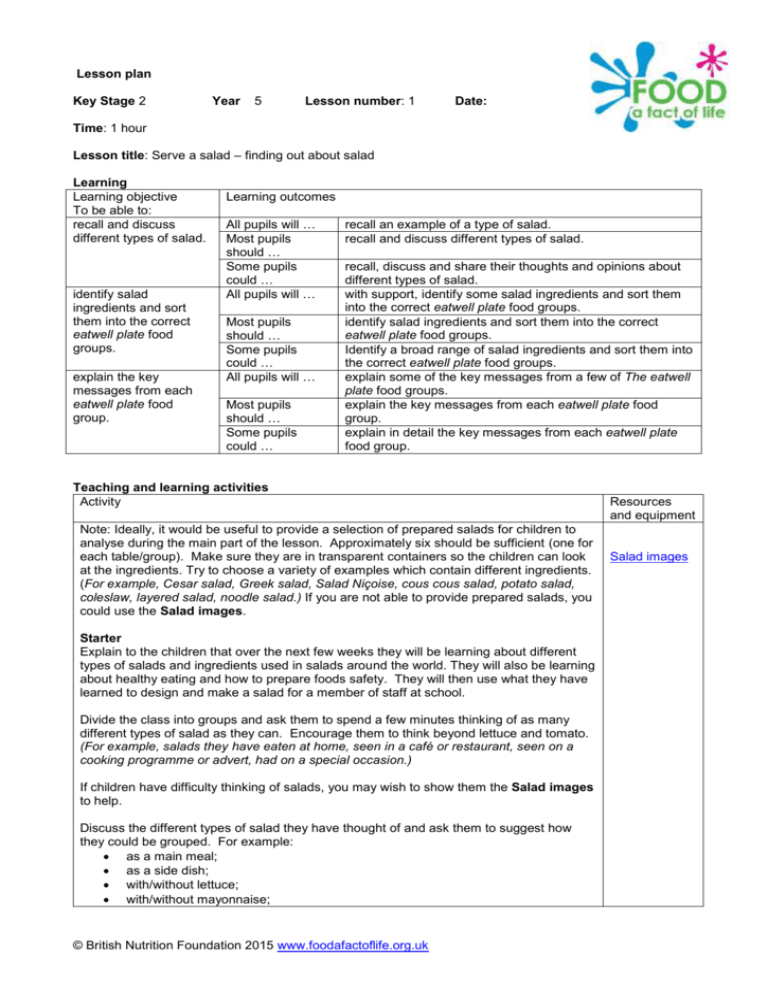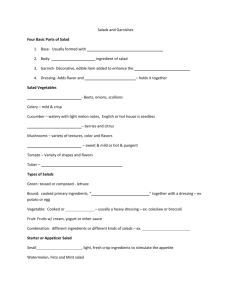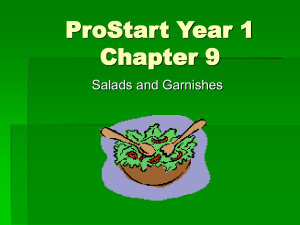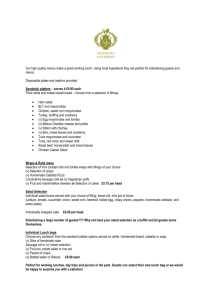Year 5 lesson 1.
advertisement

Lesson plan Key Stage 2 Year 5 Lesson number: 1 Date: Time: 1 hour Lesson title: Serve a salad – finding out about salad Learning Learning objective To be able to: recall and discuss different types of salad. identify salad ingredients and sort them into the correct eatwell plate food groups. explain the key messages from each eatwell plate food group. Learning outcomes All pupils will … Most pupils should … Some pupils could … All pupils will … Most pupils should … Some pupils could … All pupils will … Most pupils should … Some pupils could … recall an example of a type of salad. recall and discuss different types of salad. recall, discuss and share their thoughts and opinions about different types of salad. with support, identify some salad ingredients and sort them into the correct eatwell plate food groups. identify salad ingredients and sort them into the correct eatwell plate food groups. Identify a broad range of salad ingredients and sort them into the correct eatwell plate food groups. explain some of the key messages from a few of The eatwell plate food groups. explain the key messages from each eatwell plate food group. explain in detail the key messages from each eatwell plate food group. Teaching and learning activities Activity Note: Ideally, it would be useful to provide a selection of prepared salads for children to analyse during the main part of the lesson. Approximately six should be sufficient (one for each table/group). Make sure they are in transparent containers so the children can look at the ingredients. Try to choose a variety of examples which contain different ingredients. (For example, Cesar salad, Greek salad, Salad Niçoise, cous cous salad, potato salad, coleslaw, layered salad, noodle salad.) If you are not able to provide prepared salads, you could use the Salad images. Starter Explain to the children that over the next few weeks they will be learning about different types of salads and ingredients used in salads around the world. They will also be learning about healthy eating and how to prepare foods safety. They will then use what they have learned to design and make a salad for a member of staff at school. Divide the class into groups and ask them to spend a few minutes thinking of as many different types of salad as they can. Encourage them to think beyond lettuce and tomato. (For example, salads they have eaten at home, seen in a café or restaurant, seen on a cooking programme or advert, had on a special occasion.) If children have difficulty thinking of salads, you may wish to show them the Salad images to help. Discuss the different types of salad they have thought of and ask them to suggest how they could be grouped. For example: as a main meal; as a side dish; with/without lettuce; with/without mayonnaise; © British Nutrition Foundation 2015 www.foodafactoflife.org.uk Resources and equipment Salad images with foods from the Meat, fish, eggs, beans and other non-diary sources of protein group; with foods from the Bread, rice, potatoes, pasta and other starchy foods group. Question the children: Have you had a salad? What were the main ingredients in your salad? What was your favourite ingredient? Main Explain to the children that they will be analysing some prepared salads (or using the Salad images) to see what ingredients they contain and how they can contribute to a healthy diet. The children will need a copy of the Blank eatwell plate worksheet. Organise the children in to six groups and give each group a salad (or Salad image). Explain to the children that they should pass it around, look at the ingredients and note them on their Blank eatwell plate worksheet in the correct food group. They will need to allocate a colour to each salad and mark each ingredient from that salad with the same colour. They can create a key to show which colour relates to which salad. This will allow them to identify (at a glance) how each salad contributes to The eatwell plate. Blank eatwell plate worksheet Salads (prepared) x 6 or Salad images Swap the salads (Salad images) around the groups and allow the children to analyse some or all of them. Display The eatwell plate image (Eatwell plate poster or Eatwell plate PowerPoint slide). Taking each salad in turn, ask the children which ingredients they identified and discuss and where they belong in The eatwell plate. Eatwell plate PowerPoint presentation Point to each food group on The eatwell plate and ask children to explain the key messages relating each food group. Fruit and vegetables – have at least five portions every day. Bread, rice, potatoes, pasta and other starchy foods – have foods from this group with every meal. Milk and dairy foods – have some foods from this group every day. Meat, fish, eggs, beans and other non-dairy sources of protein – have some food from this group every day. Foods and drinks high in fat and or sugar – limit foods from this group, only have small amounts/occasionally. Eatwell plate poster Take one of the salads and discuss how it contributes to The eatwell plate. Ask the children what else would be needed as well as this salad to make a healthy day’s diet. (E.g. drinks, foods from the four main (largest) food groups, more foods from the two largest groups.) Draw children’s attention to the Bread, rice, potatoes, pasta and other starchy foods group and the Fruit and vegetable group. Explain to the children that each of these groups makes a third of The eatwell plate. This means a third of what we eat should come from the foods in the Fruit and vegetable group and another third should come from Bread, rice, potatoes, pasta and other starchy foods group. Explain to the children that when they make their salad they will need to include plenty of foods from these two food groups. Plenary Show a few of dishes from the World food cards and ask the children to identify the foods in them and the groups where the foods belong. Question them: Does this dish include foods from the four main (largest) eatwell plate groups? Which of the four main food group/s are not included in this dish? Are the largest amounts of food in this dish from the two largest food groups? What else could be eaten (as well as this dish) during the day to match a day’s diet with the The eatwell plate food group proportions (focusing on the four main groups)? © British Nutrition Foundation 2015 www.foodafactoflife.org.uk World food cards Remind children that every meal does not have to meet The eatwell plate proportions but it is useful to try and keep a day’s diet in portion with the plate so we can make sure we are getting a healthy, varied diet. Related activity ideas Encourage the children to collect salad images and recipes (e.g. from magazines, supermarket recipe cards). Challenge the children to find salad recipes on the Food – a fact of life website. If you have time, you could make one/some of these with the children to provide extra food skills practice. Alternatively, they could make them at home with their parent/carers. Task the children to find out which salads their families like, have seen or would like to try. Use Make a balanced plate and Make a healthy lunchbox computer games to help children revise key information about The eatwell plate. Salad recipes on Food – a fact of life: Cous cous Royal rice Splendid seaside salad Coleslaw Stripy salad pot Crunchy winter salad Make a balanced plate Make a healthy lunchbox © British Nutrition Foundation 2015 www.foodafactoflife.org.uk




